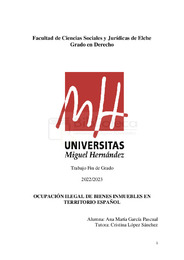Por favor, use este identificador para citar o enlazar este ítem:
https://hdl.handle.net/11000/29262Registro completo de metadatos
| Campo DC | Valor | Lengua/Idioma |
|---|---|---|
| dc.contributor.advisor | López Sánchez, Cristina | - |
| dc.contributor.author | García Pascual, Ana María | - |
| dc.contributor.other | Departamentos de la UMH::Ciencia Jurídica | es_ES |
| dc.date.accessioned | 2023-05-24T10:26:18Z | - |
| dc.date.available | 2023-05-24T10:26:18Z | - |
| dc.date.created | 2023-02 | - |
| dc.identifier.uri | https://hdl.handle.net/11000/29262 | - |
| dc.description.abstract | El presente trabajo tiene por objeto tratar el tema de la ocupación ilegal de viviendas en España en los últimos tiempos y diferenciarlo de la okupación como movimiento radical de algunas organizaciones a fin de que se tuviese en cuenta a los sectores más marginales de la población. También relacionaremos este tema con el derecho a la propiedad (art.33 CE) y el derecho a la vivienda digna y adecuada (art.47 CE) como principio rector de la política social y económica. El Gobierno de España ha facilitado muy pocos datos en relación con el número de viviendas ilegales ocupadas en nuestro país, sin embargo, la Organización Nacional de Afectados por la Okupación calcula que a día de hoy habría cerca de 120.000 inmuebles ocupados superando la cifra del millón de afectados por dichos actos. A raíz de estos hechos, se estima que se interponen cerca de 40 denuncias diarias por usurpación y allanamiento de morada, conceptos que trataremos en el presente trabajo así como las diversas maneras de actuar judicialmente para proteger y defender nuestras viviendas. | es_ES |
| dc.description.abstract | The purpose of this paper is to address the issue of ilegal occupation of homes in Spain in recent times and differentiate it from squatting as a radical movement of some organizations in order to take into account the most marginal sectors of the population. We will also relate this topic to the right to property (art.33 CE) and the right to dignified and adequate housing (art.47 CE) as a guiding principle of social and economic policy. The Government of Spain has provided very little data in relation to the number of illegally occupied homes in our country, however, the National Organization of People Affected by Squatting estimates that today there would be close to 120,000 occupied properties, exceeding the figure of one million. Those affected by suchacts. As a result of these events, it is estimated that about 40 daily complaints are filed for usurpation and trespassing, concepts that we will discuss in this paper as well as the various ways to actjudicially to protect and defend our homes. | es_ES |
| dc.format | application/pdf | es_ES |
| dc.format.extent | 53 | es_ES |
| dc.language.iso | spa | es_ES |
| dc.publisher | Universidad Miguel Hernández de Elche | es_ES |
| dc.rights | info:eu-repo/semantics/openAccess | es_ES |
| dc.rights.uri | http://creativecommons.org/licenses/by-nc-nd/4.0/ | * |
| dc.subject | okupación | es_ES |
| dc.subject | ocupas | es_ES |
| dc.subject | vivienda | es_ES |
| dc.subject | propiedad | es_ES |
| dc.subject | desalojo | es_ES |
| dc.subject | squatting | es_ES |
| dc.subject | squatters | es_ES |
| dc.subject | housing | es_ES |
| dc.subject | property | es_ES |
| dc.subject | eviction | es_ES |
| dc.subject.other | CDU::3 - Ciencias sociales::34 - Derecho | es_ES |
| dc.title | Ocupación de bienes inmuebles en territorio español | es_ES |
| dc.type | info:eu-repo/semantics/bachelorThesis | es_ES |

Ver/Abrir:
TFG-García Pascual Ana, María.pdf
1,5 MB
Adobe PDF
Compartir:
 La licencia se describe como: Atribución-NonComercial-NoDerivada 4.0 Internacional.
La licencia se describe como: Atribución-NonComercial-NoDerivada 4.0 Internacional.
.png)